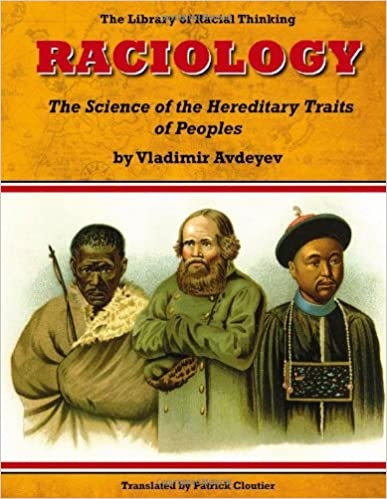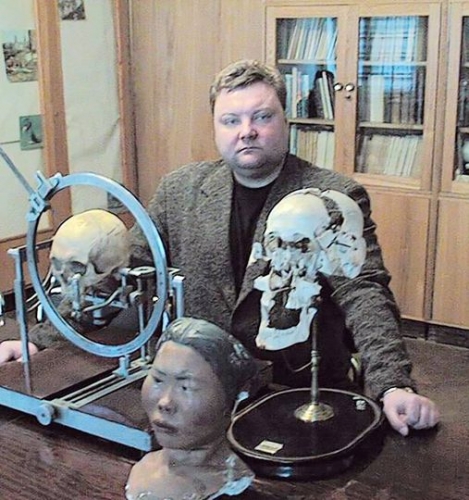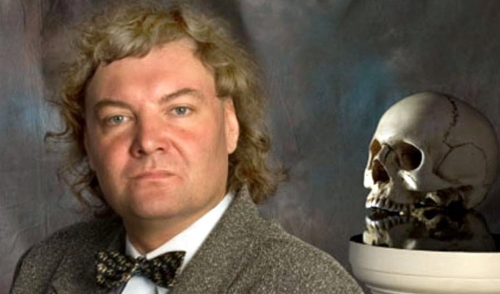mardi, 08 décembre 2020
Vladimir Avdeyev’s RACIOLOGY

Vladimir Avdeyev’s RACIOLOGY
Vladimir Avdeyev, écrivain et raciologue russe, éditeur de nombreux textes émanant d'antropologues classiques et modernes, auteur du livre ′′ RACIOLOGY ′′, est mort le 5 décembre 2020 à l'âge de 58 ans. Homme chaleureux et convivial, il nous laisse avec grand chagrin. Nos condoléances à tous ses proches !
Vladimir Avdeyev’s RACIOLOGY has been translated into English (with a foreword by Dr. Kevin MacDonald) and can be ordered here:
http://www.lulu.com/product/paperback/raciology/15147189
Raciology, by Vladimir Avdeyev, is about the science of the hereditary traits of peoples and races. From metopism to dental traits, from the Rolando and Sylvius brain fissures to the Jewish brain signature, from the ancient Aryans to Nordic peoples, from the Out-of-Africa Theory of Evolution to Polycentric Evolution, from dermatoglyphics (thumbprints) to eye shape, Vladimir Avdeyev discusses it all, with references to works that span of a period of time, which stretches from the present to deep antiquity. His work discusses the civilization-building traits of the European; he identifies the founders of the Classical civilizations which stretched Spain to India, from Britain to Egypt, as the Aryans; he examines some cultural traits of the races, such as ritual scarring. His work rebuts the fashionable trends of modern Western anthropology. 375 pages with over 200 photos, maps, and illustrations. Cover art by MDesign. Foreword by Dr. Kevin MacDonald.
http://www.eutimes.net/2007/12/vladimir-avdeyev-race-scie...
Race realism, Russian-style
A review of "Rasiologia" by Vladimir Avdeyev
Moscow : Biblioteka Rasovoy Mysli. 2007, 2nd edition, 665 pp.
 (With introductions by Andrey Savelev, a delegate of the Russian Duma {Russian Parliament} and close personal friend of Avdeyev, and by Valeri Solovei, a historian and member of the liberal Gorbachev Foundation. The work is used as a textbook by the Department of Anthropology at Moscow State University.)
(With introductions by Andrey Savelev, a delegate of the Russian Duma {Russian Parliament} and close personal friend of Avdeyev, and by Valeri Solovei, a historian and member of the liberal Gorbachev Foundation. The work is used as a textbook by the Department of Anthropology at Moscow State University.)
Like it or not, Raciology is a book that illustrates how free speech about Galtonian topics has sunk in the West – and resurfaced in Moscow (where Communism had formerly banned scientific racism). In the West of the past fifteen years, only mail-order and vanity publishers would deliver the thoughts and evidence of academic race realists Art Jensen, Phil Rushton, Richard Lynn, Glayde Whitney, Helmuth Nyborg and myself to the Western public. In leading British universities, Geoffrey Sampson, Satoshi Kanazawa, Armand Leroi, Frank Ellis and David Coleman were all silenced by administrators when they talked of race; and I was sacked. By contrast, in Vladimir Putin’s Russia, with its serious concern with ethnic (often Muslim) problems and the disruptive advance of Western ‘liberal interventionism’ and multicultural illusionism in ex-Yugoslavia, Afghanistan and Iraq, the 46-year-old Vladimir Borisovich Avdeyev, an engineer and Soviet Army officer by origin, later a journalist, is allowed not only to edit the prestigious Athenaeum Magazine but to have a publisher for his thoroughgoing racial analysis of the world’s problems, combining lively (if traditional) ideas with scholarly detail and vivid illustrations (not disdaining the splendidly buttocked ‘Hottentot Venus’ who was displayed in Paris a century ago). Avdeyev has mastered the history of Western racial thought from the Enlightenment days of Immanuel Kant and David Hume to the twentieth century and provided an unparalleled summary. Only John Baker’s Race (1967, Oxford University Press — but withdrawn after Baker’s death) would hold a candle to Avdeyev’s magisterial effort.
Essentially, Avdeyev presents the Nordic peoples (including thereby the Slavs and Caucasoid Russians) as the racial group responsible for the bulk of culture, science and lawful governance in the world. He writes (p. 156): “In the very heart of Europe — at the time of the formation of the first states, the creation of literacy, religion, culture, technology and the bases of civilisation and jurisprudence — there was no mention of Mongols, Negroes, and cross-breeds. All the epic creation belonged entirely to the White man of pure race — to his will, genes, and far-sightedness.” (The term “Nordic race” was apparently not coined by a German or by the mighty William McDougall (of the universities of Cambridge, London, Oxford and Harvard), but by the French-parented but Russian-born Joseph Deniker (1852-1918). And, contrary to communist propaganda, Hitler apparently took a dim view only of Bolsheviks, not of East Europeans in general: “The Third Reich did not fight with Slavism, but with threat of bolshevism to the fundamentals of European civilisation… It was the Bolsheviks, such as Mehlis and open racists like Ilya Ehrenburg that those in Himmler’s department described as “Untermenschen” in an exceedingly anthropological sense of the word” (p.123).) In particular, Avdeyev rehearses the Nordics’ economic and psychometric achievements and provides physical measurements (including some of his own) which he takes to attest Nordic superiority — for Blacks, in particular, he finds to be distinguished by strength and physicality rather than by cranial development. In all this, Avdeyev is well in line with the modern London School and it is good to think that Russian scholars and students will be led by Raciology to join the great debate that Western politicians, publishers and university authorities have done their best to suppress.

It is true that Avdeyev will discompose Western race realists almost as much as Western anti-racists. He takes a Nazistic line about the Jews, reckoning them uncultured ‘nomads’ rather than recognizing (1) their having been beaten into the wilderness by Rome, (2) their high IQs, and (3) their ten-fold over-representation among Nobel prizewinners (compared to other Americans). Strangely, he does not especially want to criticize the Jewish elite for the manufacture of multiculturalism and PeeCee in the West (not in Israel, of course, where strict race realism rules) and its weird importation to the West, qua blessed ‘minorities’ which all should love, of millions of Jewry’s most deadly Muslim enemies. He is equally dismissive of the Chinese — verily Johnsonian in his assertion of White superiority, even thinking some of the higher Chinese (as also Egyptian) cultural attainments attributable to stray Caucasoid genes, and not admitting the onward march of modern China to make America its debtor. Avdeyev equally declines to follow modern Western ‘out of Africa’ thinking about evolution, preferring to believe that the main human races descended quite separately from different types of ape. (He backs this up with reasoning involving the proneness of different races to different diseases and tolerance to different kinds of food, smell/taste [as identified in cannibals].) He has a special line of his own in believing that the West, in its right-handedness and left-to-right script, is thus importantly distinguished from Muslims, Jews, Egyptians, homosexuals and the Chinese – not apparently recalling that Africans are both conspicuously more right-handed and less homosexual than Europeans. He also wants to derive significance from Blacks’ tendencies to squat and from alleged Asian proneness to melancholy. And he disdains Western convention in deploring ‘mixed marriages’ – believing such unions to yield unhealthy and otherwise degenerate children (with large genetic ‘mongol stains’ on their bottoms, at least in Brazil and Ecuador). (“The propaganda of free love is of no satisfaction, since, in the long run, it destroys races. Any search for sensory-biological diversity is fraught with evolutionary irresponsibility”– p.265. What Avdeyev makes of the half-caste Tiger Woods, Colin Powell, Condoleeza Rice and Naomi Campbell is not recorded….) Still more problematic, Avdeyev’s system of referencing is non-Western, making it hard to follow up many of his mentions of the works of the scholars and medics of Europe’s past who did so much to identify the racial differences that had been strangely ignored by Ancient Greece, Rome and Christianity. And, though Avdeyev’s heart is surely in the right place about plucky Serbia, he doesn’t admit that 25% of the Russian Army is now Muslim and thus multicultural and incapable of deployment into Kosovo.

Nevertheless, Avdeyev’s thoughts and scholarship fully deserve discussion and development rather than the suppression which they would promptly receive if he attempted to publish in the West. Above all, Avdeyev makes the strong case that ‘race is everything: literature, science, art — in a word, civilization — depend on it,’ as Edinburgh University’s top anatomist Robert Knox explained in 1850. And Avdeyev is also properly agitated not so much about Negroes (among whom he lived for a while, studying their varied tastes in cannibalism — one sub-section, 4-pages long, is called “Racial smells and passions of cannibals”) as against Whites who betray their own race and science (for Darwin’s great book was called On the Origin of Species by Means of Natural Selection, or the Preservation of Favoured Races in the Struggle for Life), wear dreadlocks or flip-flops, listen to heavily rhythmic music, shake or otherwise draw attention to their genitals while dancing and fail to appreciate Russia’s eugenic possibilities of breeding from the likes of Red Army sex symbol Dana Borisova (e.g. http://www.rususa.com/photo/gallery.asp-galleryid-14-imag...). One only hopes his next work might concentrate — as the London School has done — more on intelligence and IQ than on features of less immediate relevance to explaining the human races’ different levels of cultural advance.
CHRIS BRAND (author of ‘The g Factor’, 1996, Wiley DePublisher), Edinburgh, 2008.

Avdeyev’s book has eight chapters: 1) Racial Science and Anthropology: What are the differences? 2) The Fair Race: Historiography and Anthropology. 3) The Biological Foundation of the Northern Conception of the World. 4) Thoughts about Racial Prejudices. 5) A New Paradigm in Racial Science. 6) The Anti-Racial Myth of the “Melting Pot”. 7) Racial-ideological Neurology, and finally, the striking chapter 8, A Racial Theory of Time. The book contains many photographs and illustrations.
For another review and comments, see American Renaissance, November 2007, http://www.amren.com/mtnews/archives/2007/12/vladimir_avd....
17:13 Publié dans anthropologie, Ethnologie, Hommages, Livre, Livre | Lien permanent | Commentaires (0) | Tags : vladimir avdeev, vladimir avdeyev, ethnologie, raciologie, anthropologie, russie, livre, hommage |  |
|  del.icio.us |
del.icio.us |  |
|  Digg |
Digg | ![]() Facebook
Facebook


